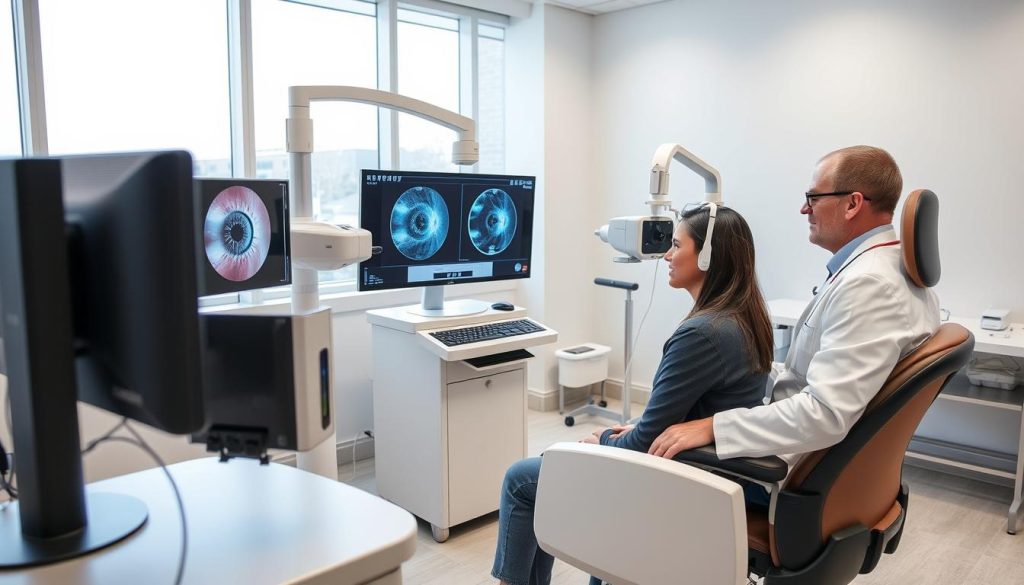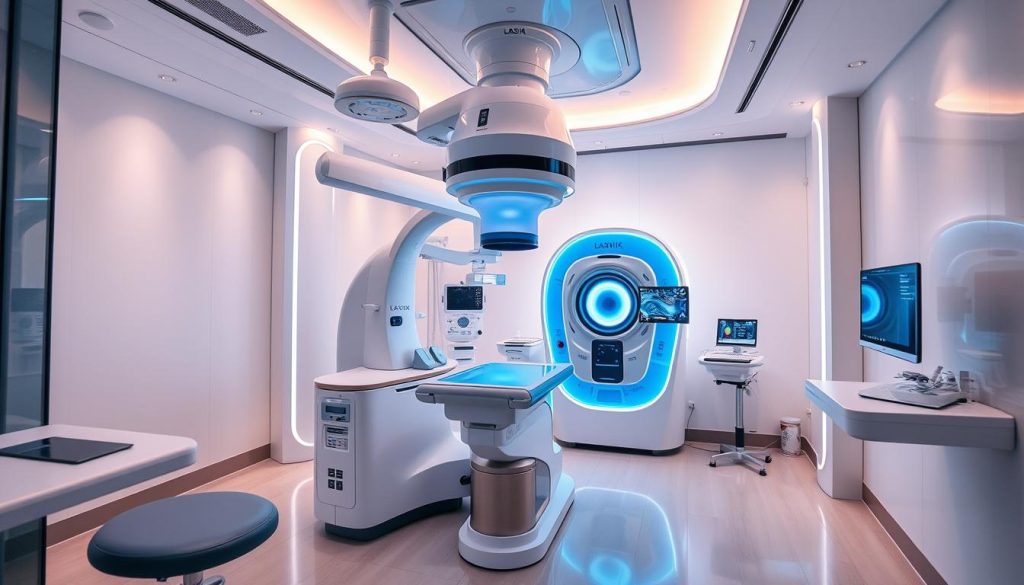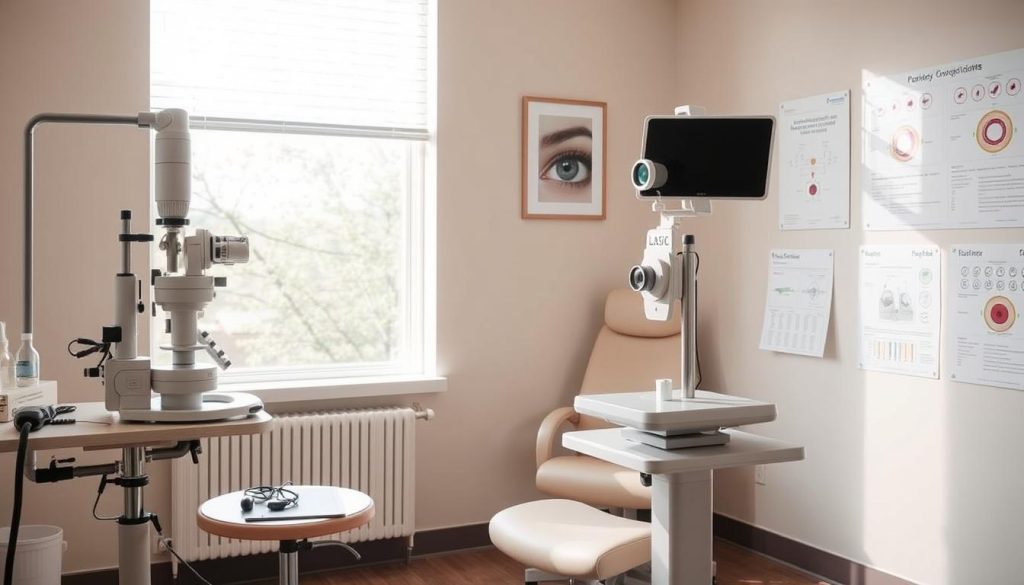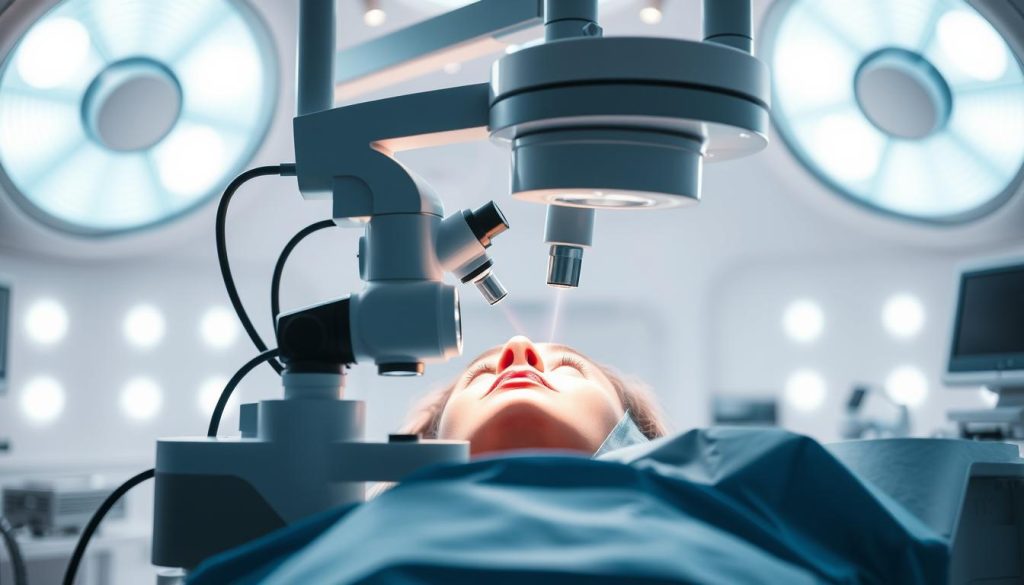Lasic eye surgery has changed how we see the world. It lets people see clearly without glasses or contacts. This new way of correcting vision has improved many lives.
This surgery uses a laser to reshape the cornea. This helps focus better and see more clearly. It’s popular because it heals fast and works well for many people. Many can now see 20/20 or better without glasses.
Doctors all over the world use Lasic eye surgery. It’s seen as safe and effective for common vision issues. It’s a big step towards freedom from glasses and contacts. As technology gets better, Lasic will keep improving, helping more people see clearly.
Understanding Lasic Eye Surgery: A Revolutionary Vision Correction Method
Lasic eye surgery has changed how we treat vision problems. It reshapes the cornea to let light focus right on the retina. This means clearer vision without glasses or contacts.
The Science Behind Laser Vision Correction
Lasic uses laser technology to change the cornea’s shape. This ophthalmology treatment fixes vision issues by adjusting light entry. It removes small amounts of tissue for better focus.
Evolution of Refractive Surgery Technology
Refractive surgery has evolved a lot. Early methods used manual cuts, but now Lasic uses lasers. These updates mean more accuracy, quicker healing, and better vision for patients.
Key Benefits of Modern Lasic Procedures
Modern Lasic brings many benefits:
- Quick procedure (usually under 30 minutes)
- Minimal discomfort
- Rapid vision improvement
- Reduced dependence on glasses or contacts
- Long-lasting results
Lasic remains a top choice for better vision thanks to its success and ongoing tech improvements.
Common Vision Problems Corrected by Lasic Surgery
Lasic surgery is a powerful solution for many vision issues. It reshapes the cornea to correct refractive errors. This can greatly improve vision for many patients.

Myopia makes distant objects blurry because light focuses in front of the retina. Hyperopia causes nearby objects to appear fuzzy because light focuses behind the retina. Astigmatism makes vision distorted at all distances due to an irregular cornea shape.
Lasic surgery reshapes the cornea to fix these problems. It allows light to focus correctly on the retina. The surgery’s precision means it can be tailored to each patient’s needs.
| Vision Problem | Corneal Shape | Lasic Correction |
|---|---|---|
| Myopia | Too steep | Flattens central cornea |
| Hyperopia | Too flat | Steepens central cornea |
| Astigmatism | Irregularly curved | Smooths corneal surface |
The improvement in vision from Lasic surgery varies. It depends on the severity of the initial error. Many patients see a big improvement, sometimes even achieving 20/20 vision or better.
The Complete Lasic Eye Surgery Procedure Guide
Lasic eye surgery is a groundbreaking ophthalmology treatment that can dramatically improve vision. This guide walks you through the entire process, from initial consultation to recovery.
Pre-operative Assessment and Consultation
Before undergoing lasic eye surgery, patients undergo a thorough eye examination. This includes corneal mapping, pupil dilation, and refraction tests. Your doctor will review your medical history and discuss expectations to determine if you’re a suitable candidate.

During the Surgical Procedure
The lasic procedure typically takes about 30 minutes for both eyes. Here’s what to expect:
- Numbing eye drops are applied
- A small flap is created in the cornea
- Laser reshapes the cornea
- The flap is repositioned
You may feel pressure but no pain during the surgery. The laser work itself only lasts about 60 seconds per eye.
Post-operative Care and Recovery
Recovery from lasic eye surgery is usually quick. Most patients notice improved vision within 24 hours. Your doctor will provide eye drops and instructions for care. Avoid rubbing your eyes and wear protective shields while sleeping for the first week. Follow-up appointments will monitor your healing progress.
“I was amazed at how quickly I recovered. I could see clearly the very next day!”
Understanding the lasic eye surgery process can help ease any concerns. With proper care and follow-up, most patients achieve excellent vision improvement through this advanced ophthalmology treatment.
Advanced Technology in Modern Lasic Procedures
Lasic eye surgery has seen big changes with new tech. These updates have made the surgery more precise and safe. Now, patients get better results and heal faster.
Wavefront Guided Lasik Systems
Wavefront guided lasik uses advanced mapping tech. It makes a detailed 3D model of each eye’s unique flaws. This lets surgeons make treatments that fit each eye perfectly, fixing even small vision problems.

Bladeless Lasik Innovation
Bladeless lasik is a big step up in making the corneal flap. Instead of a blade, a femtosecond laser is used. This makes the surgery safer and cuts down on complications.
Topography-Guided Treatment
Topography-guided lasik goes further in personalizing treatment. It maps the cornea’s surface to fix unique problems. This leads to better vision, even for those with astigmatism or irregular corneas.
| Technology | Key Benefit | Best For |
|---|---|---|
| Wavefront Guided Lasik | Corrects subtle vision imperfections | Complex prescriptions |
| Bladeless Lasik | Increased safety and precision | All eligible patients |
| Topography-Guided | Addresses corneal irregularities | Astigmatism, irregular corneas |
These new technologies have made lasik surgery safer and more effective. Patients now see better and heal faster. These advances in vision correction are a big win.
Determining Your Candidacy for Lasic Surgery

Lasic surgery can improve your vision, but it’s not for everyone. Knowing the criteria can help figure out if you’re a good fit.
Age is important when deciding if you can get Lasic surgery. You should be 18 or older and have a stable vision prescription for at least a year. Your eye doctor will check your corneal thickness and eye health during a detailed exam.
Some medical conditions might make you not a good candidate. These include:
- Autoimmune disorders
- Diabetes
- Pregnancy or nursing
- Severe dry eye syndrome
Also, some medications can affect your eligibility for Lasic. Tell your doctor about any drugs you’re taking, including over-the-counter ones.
| Factor | Ideal Candidate | Non-Ideal Candidate |
|---|---|---|
| Age | 18+ years | Under 18 years |
| Vision Stability | Stable for 1+ year | Recent prescription changes |
| Corneal Thickness | Adequate | Too thin |
| Eye Health | Good overall health | Active eye diseases |
Every person is different. The best way to know if Lasic surgery is right for you is to get a detailed check-up from an experienced eye surgeon.
Comparing Different Types of Laser Vision Correction
Laser vision correction offers many options to improve your eyesight. Each method has its own benefits and things to consider. Let’s look at the main types of procedures available.
Traditional LASIK vs. Bladeless LASIK
LASIK is a well-known laser vision correction choice. Traditional LASIK uses a blade to make a corneal flap. Bladeless LASIK, on the other hand, uses a laser for a more precise flap and quicker recovery.
PRK (Photorefractive Keratectomy)
PRK is a good option for those with thin corneas. It removes the outer layer of the cornea instead of making a flap. This method is safer for some patients but may take longer to recover.
Conductive Keratoplasty Options
Conductive keratoplasty reshapes the cornea with radio waves. It’s often used for older adults with farsightedness. This non-laser procedure has a quick recovery but may need touch-ups later.
| Procedure | Best For | Recovery Time | Permanence |
|---|---|---|---|
| Traditional LASIK | Nearsightedness, Farsightedness, Astigmatism | 1-2 days | Long-lasting |
| Bladeless LASIK | Same as Traditional LASIK | 1-2 days | Long-lasting |
| PRK | Thin Corneas | 1-2 weeks | Long-lasting |
| Conductive Keratoplasty | Farsightedness in Older Adults | 1-2 days | May require touch-ups |
Choosing the right procedure depends on your vision needs and eye health. Talk to an eye care professional to find the best option for you.
Recovery Timeline and Post-Surgery Expectations
Lasic eye surgery is known for its quick recovery. Knowing what to expect helps manage expectations. Let’s look at the typical recovery process after this common ophthalmology treatment.
The first 24 hours are critical. Patients might see blurry vision and feel a bit uncomfortable. Resting is important during this time. By day two, many start to see their vision improve a lot.
By the end of the first week, most people can go back to their daily routines. Driving is usually okay after the first check-up. But, it’s best to avoid hard workouts for at least a week to avoid problems.
It takes about a month to fully recover. During this time, your vision will keep getting better. Some might experience dry eyes or sensitivity to light. These issues usually get better with the right care.
| Recovery Phase | Timeline | Expectations |
|---|---|---|
| Immediate | 1-2 days | Blurry vision, mild discomfort |
| Short-term | 1 week | Resume daily activities, avoid strenuous exercise |
| Long-term | 1 month | Vision stabilizes, full recovery |
The long-term effects of lasic eye surgery are usually good. Most people enjoy better vision for years. Regular eye exams help keep your eyes healthy and catch any issues early.
Potential Risks and Complications of Lasic Surgery
Lasic surgery is a common way to correct vision. It has many benefits but also some risks. Knowing these risks helps patients choose the best option for their eyes.
Common Side Effects
After Lasic, some people feel discomfort. Dry eyes, glare, and halos around lights are common. These usually go away in a few weeks or months. But sometimes, these effects can last longer.
Long-term Considerations
Lasic results usually last, but some might need more surgery later. As we get older, we might need glasses for reading. This is not because of the surgery.
| Complication | Frequency | Duration |
|---|---|---|
| Dry Eyes | Common | 1-3 months |
| Glare/Halos | Common | 2-4 weeks |
| Undercorrection | Uncommon | May require enhancement |
| Infection | Rare | Treatable if caught early |
Risk Mitigation Strategies
Choosing a skilled surgeon is key to reducing risks. Following all instructions before and after surgery is important. Regular check-ups help catch and treat any problems early.
By understanding the risks and following care tips, patients can enjoy the benefits of Lasic surgery. This way, they can avoid or lessen any complications.
Cost Analysis and Insurance Coverage
When thinking about laser vision correction, it’s important to know the costs. In the U.S., the price for Lasic eye surgery is between $2,000 and $3,000 per eye. The cost can change based on the surgeon’s skill, the technology used, and where you live.
Most health insurance doesn’t cover Lasic because it’s seen as an elective procedure. But, some vision plans or health savings accounts might help with the cost. Always check with your insurance to see what they cover.
| Expense Type | Estimated Cost |
|---|---|
| Lasic Surgery (per eye) | $2,000 – $3,000 |
| Pre-operative Exam | $100 – $300 |
| Post-operative Medications | $100 – $200 |
The cost might seem high at first, but many people save money in the long run. They no longer need to buy glasses or contacts. Many providers also offer payment plans to help make it more affordable. Think about how Lasic could improve your life and vision in the long run.
“Investing in Lasic was worth every penny. I’ve saved money on glasses and contacts, and the freedom of clear vision is priceless.” – Sarah M., Lasic Patient
Choosing the Right Lasic Surgery Center
Finding the right lasic eye surgery center is key for a good outcome. Your choice can greatly affect your vision correction success.
Surgeon Qualifications
Look for surgeons who are board certified and have specialized training in refractive surgery. Experience is important. Choose those who have done many lasic procedures.
Facility Accreditation
Make sure the center is accredited by well-known medical groups. This shows it follows high safety and quality standards for lasic eye surgery.
Patient Reviews and Success Rates
Check out what other patients say and the center’s success rates. This can tell you a lot about the center’s reputation and success in ophthalmology treatment.
| Factor | What to Look For |
|---|---|
| Surgeon Qualifications | Board certification, specialized training, years of experience |
| Facility Accreditation | Recognition by medical organizations, adherence to safety standards |
| Patient Reviews | Positive feedback, high satisfaction rates, successful outcomes |
| Technology | Latest lasic equipment, advanced diagnostic tools |
| Consultation Process | Thorough assessment, clear communication, personalized treatment plans |
Ask about the surgeon’s experience and the center’s success rates during consultations. Be cautious of places that promise too much or rush you. Your comfort and confidence in the lasic surgery center are essential for a successful vision correction journey.
Alternative Vision Correction Methods
Lasic surgery is well-known, but there are other ways to see clearly. Photorefractive keratectomy (PRK) is one. It changes the cornea’s surface to fix vision issues.
PRK is different from Lasic because it doesn’t make a flap in the cornea. It removes the outer cornea layer and uses laser treatment on the surface. This is good for people with thin corneas or active lives.
SMILE (Small Incision Lenticule Extraction) is another choice. It’s a small procedure that uses a laser to create a tissue disc in the cornea. Then, it’s removed through a small cut. SMILE heals fast and might lower dry eye risk.
Orthokeratology is a non-surgical option. It uses special contact lenses worn at night to reshape the cornea. This gives clear vision during the day without glasses or contacts.
- PRK: Suitable for thin corneas
- SMILE: Minimally invasive with quick recovery
- Orthokeratology: Non-surgical, reversible option
Looking into these options can help you choose the best vision correction for you. It depends on your needs and lifestyle.
Latest Innovations in Corneal Reshaping Technology
Corneal reshaping technology has seen big changes in recent years. These updates have changed vision correction, making treatments more precise and tailored to each person.
Advanced Mapping Techniques
New mapping methods have changed how eye surgeons work. High-resolution wavefront aberrometry makes detailed eye maps. This tech helps spot vision issues more accurately, leading to better LASIK results.
Corneal topography has also gotten better. It creates a 3D map of the cornea’s surface. This helps surgeons find and fix small problems. Together, these methods let doctors create treatments that fit each patient perfectly.
Precision Enhancement Methods
Laser use in reshaping has become more accurate. Iris registration technology makes sure the laser hits the right spot, even if the eye moves. Eye tracking systems adjust the laser as needed, keeping it precise.
These advances have made vision correction safer and more effective. As research keeps going, we’ll see even more breakthroughs in eye surgery.
Preparing for Your Lasic Procedure
Getting ready for lasic eye surgery is all about planning. This guide will help you get ready for your vision journey.
In the weeks before your surgery, stop wearing contacts. This lets your corneas go back to their natural shape. It’s important for getting accurate measurements. Also, avoid certain medicines and supplements that might make you bleed more.
On the day of your surgery, wear comfy clothes without makeup or perfume. Make sure someone can drive you home. Bring sunglasses to protect your eyes after the surgery.
- Stop wearing contacts 2-4 weeks before surgery
- Avoid alcohol 24 hours prior
- Eat a light meal before arrival
- Bring all paperwork and insurance information
Mental prep is important. Try relaxation techniques to calm your nerves. Talk to your surgeon about what to expect. Remember, lasic eye surgery is quick and often very successful for improving your vision.
“I felt so much more at ease going into my lasic procedure after following these preparation steps. It made a world of difference.” – Sarah, lasic patient
By following this guide, you’ll be ready for your lasic eye surgery. This will help make your procedure smooth and your results the best they can be.
Long-term Results and Vision Stability
Laser vision correction offers lasting benefits for many patients. Over the years, refractive surgery has improved, leading to better results. Knowing what to expect can help those thinking about this life-changing procedure.
Success Rate Statistics
Research shows laser vision correction has high success rates. Many patients see 20/20 or better after surgery. Here’s a look at long-term results:
| Time Post-Surgery | 20/20 Vision or Better | Patient Satisfaction |
|---|---|---|
| 1 Year | 95% | 98% |
| 5 Years | 92% | 96% |
| 10 Years | 88% | 94% |
Factors Affecting Long-term Outcomes
Several factors can affect vision stability after surgery:
- Age at time of surgery
- Initial prescription strength
- Eye health and healing response
- Post-operative care adherence
Those with higher prescriptions might see slight changes over time. Some may develop presbyopia, a condition that affects near vision with age. If needed, enhancement procedures can fix minor vision changes.
Laser vision correction often provides more stable results compared to other methods. Regular eye exams are key to keeping vision sharp and eyes healthy after surgery. With the right care and expectations, most patients enjoy clear vision for years after their procedure.
Patient Testimonials and Success Stories
Real-life stories of Lasik eye surgery patients show how it can change lives. Sarah, a 35-year-old teacher, had severe myopia. She said, “After years of thick glasses, I can now see clearly without them. It’s like experiencing the world anew.”
Mark, a 42-year-old architect, got Lasik for astigmatism. He said, “My work requires precision, and now I can draft designs without strain. The recovery was smooth, and the results exceeded my expectations.”
Not all stories are perfect, though. Emily, a 28-year-old athlete, had dry eyes after surgery. “The discomfort lasted a few weeks, but with proper care, it resolved completely. Now I enjoy my sports without vision issues,” she explained.
FAQ
Q: What is Lasic eye surgery?
A: Lasic eye surgery reshapes the cornea with laser technology. It corrects nearsightedness, farsightedness, and astigmatism. This makes glasses or contact lenses less needed.
Q: How long does the Lasic procedure take?
A: The Lasic procedure takes 15-30 minutes for both eyes. But, you should plan to spend 2-3 hours at the center. This includes preparation and recovery time.
Q: Is Lasic eye surgery painful?
A: Lasic surgery is not painful. Eye drops numb the area before the procedure. You might feel pressure during it. After, some mild discomfort or irritation is normal, but eye drops help manage it.
Q: How long is the recovery period after Lasic?
A: Vision improves within 24 hours after Lasic. Full recovery takes a few days to a week. Vision will keep getting better over weeks. But, it can take up to 3-6 months for complete stabilization.
Q: Who is a good candidate for Lasic eye surgery?
A: Good candidates are 18 or older with stable vision for a year. They must have enough corneal thickness and good eye health. Certain conditions or medications might affect candidacy, which is checked during a detailed eye exam.
Q: What is the difference between traditional Lasic and bladeless Lasic?
A: Traditional Lasic uses a microkeratome blade. Bladeless Lasic uses a femtosecond laser. Bladeless Lasic is safer for thinner corneas and offers more precise flap creation.
Q: What are the possible risks of Lasic surgery?
A: Lasic is generally safe but has risks. These include dry eyes, glare, halos, under or over-correction, and rare loss of vision. Always discuss these risks with your surgeon.
Q: How much does Lasic eye surgery cost?
A: Lasic costs vary by technology, surgeon experience, and location. In the U.S., it’s ,000 to ,000 per eye. Financing options are often available.
Q: Is Lasic covered by insurance?
A: Most insurance plans don’t cover Lasic. But, some vision plans offer discounts. Health savings accounts (HSAs) or flexible spending accounts (FSAs) can help pay for it.
Q: What is wavefront-guided Lasic?
A: Wavefront-guided Lasic uses 3D measurements for a personalized treatment. It aims for better vision and less risk of night vision problems.
Q: How long do the results of Lasic last?
A: Lasic results are usually permanent. But, age-related vision changes like presbyopia can occur. Some might need an enhancement after years to keep results optimal.
Q: What is conductive keratoplasty?
A: Conductive keratoplasty uses radiofrequency to reshape the cornea. It treats farsightedness and presbyopia in older adults, without laser.
Q: What is photorefractive keratectomy (PRK)?
A: PRK is an alternative to Lasic. It removes the cornea’s outer layer before reshaping. It’s for patients with thin corneas or certain jobs.


















